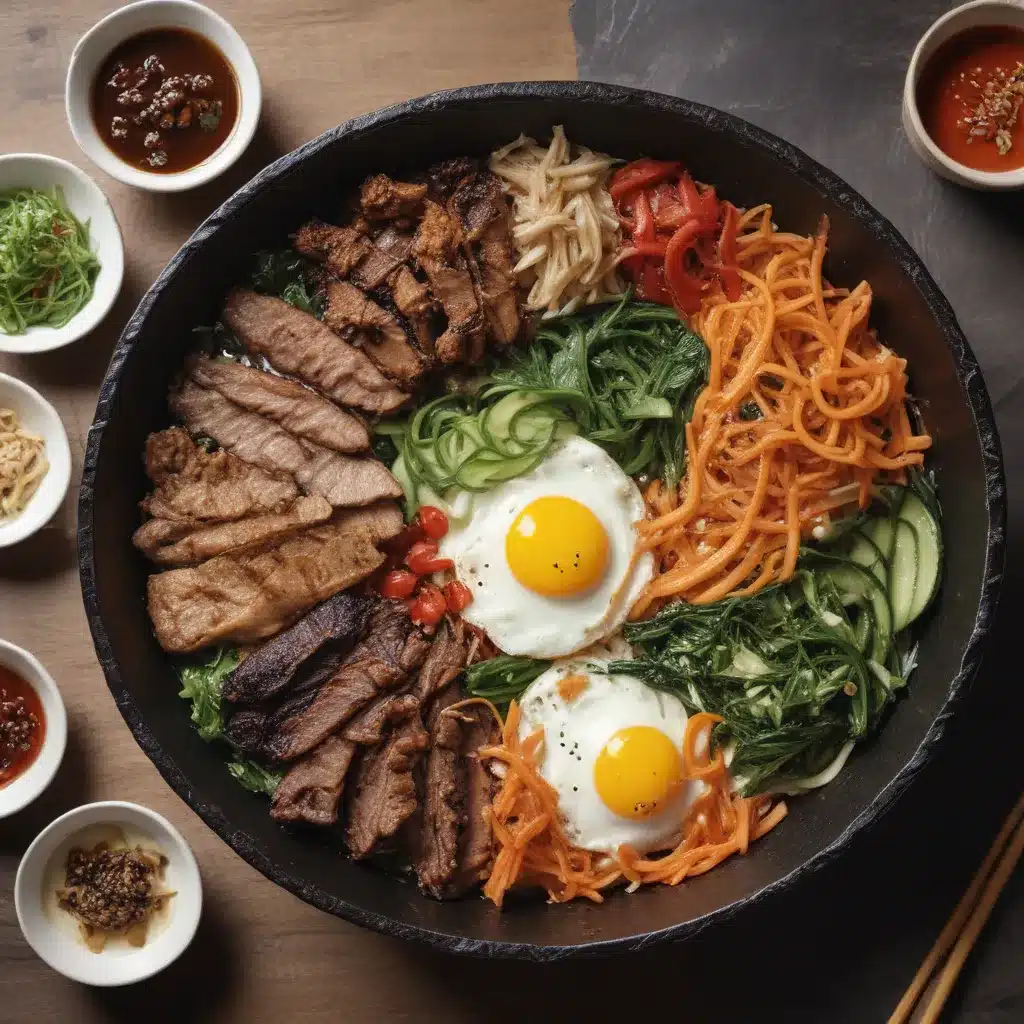
The Allure of Korean Cuisine
As I strolled down the bustling streets of Boston’s Koreatown, the aroma of sizzling meat and fragrant spices wafted through the air, beckoning me to explore the vibrant culinary scene. Growing up in a small town, my exposure to Korean cuisine was limited, but stepping into the heart of this dynamic food culture opened my eyes to a world of flavors I never knew existed.
The first time I sank my teeth into a juicy piece of samgyeopsal (thick, marinated pork belly), I was transported to another dimension. The combination of the smoky, charred exterior and the tender, succulent interior was a revelation. Wrapped in crisp lettuce leaves with a swipe of salty-sweet soybean paste, each bite was a harmonious balance of textures and tastes.
But it wasn’t just the Korean BBQ that captivated me. As I ventured deeper into the culinary landscape, I discovered a tapestry of traditional dishes that showcased the ingenuity and diversity of Korean cuisine. From the fiery kimchi jjigae (kimchi stew) to the addictive tteokbokki (spicy rice cakes), each plate told a story of Korea’s rich cultural heritage.
Rediscovering Classics with a Twist
As I explored the restaurants and eateries in Koreatown, I was struck by the way chefs were reinterpreting traditional Korean dishes. At Korean Garden, a local favorite, I discovered a modern take on the classic dolsot bibimbap. The sizzling stone bowl arrived at my table, filled with a vibrant medley of sautéed vegetables, tender beef, and a perfectly cooked egg, all nestled atop a bed of fluffy rice. As I mixed the ingredients together, the crisp, golden crust at the bottom added a delightful textural contrast to the dish.
Intrigued, I ventured further, sampling a delectable haemul pajeon (seafood pancake) that had been reimagined with a contemporary twist. The paper-thin, lacy exterior concealed a bounty of fresh shrimp, squid, and scallions, all bound together by a savory batter. Dipped in a tangy soy-and-vinegar sauce, each bite was a symphony of flavors and textures.
Embracing the Unexpected
As I continued my culinary journey, I discovered that Korean cuisine was not just about the well-known dishes, but also the unexpected gems that lay waiting to be uncovered. At a local market, I stumbled upon a bustling stall selling sundae, a traditional Korean sausage made with pork or beef intestines. Admittedly, I was hesitant at first, but the owner’s infectious enthusiasm and the mouthwatering aroma soon convinced me to give it a try.
To my surprise, the sundae was a revelation. The chewy, savory sausage, enhanced by a blend of rice, vegetables, and cellophane noodles, was a delightful departure from the norm. As I savored each bite, I realized that the true beauty of Korean cuisine lies in its ability to challenge preconceptions and introduce unexpected delights.
Discover the Depth of Korean Flavors
As I delved deeper into the world of Korean cuisine, I encountered a vast array of dishes that showcased the ingenuity and depth of its culinary heritage. From the spicy and complex budae jjigae (army base stew) to the comforting and nourishing samgyetang (ginseng chicken soup), each plate revealed a unique perspective on Korean flavors.
One dish that particularly intrigued me was the naengmyeon, a refreshing cold noodle dish that proved to be the perfect antidote to the sweltering Boston summers. The thin, chewy buckwheat noodles, immersed in an icy broth infused with vinegar and mustard, offered a delightful contrast to the surrounding heat.
As I navigated the bustling streets of Koreatown, I encountered a vibrant food culture that celebrated tradition while embracing innovation. Chefs and restaurateurs were not content to simply replicate the classics; they were actively redefining the boundaries of Korean cuisine, weaving in global influences and personal interpretations to create dishes that were both familiar and delightfully novel.
Embracing the Shared Experience
At the heart of Korean cuisine lies a profound sense of community and shared experience. Meals are not merely sustenance, but rather social gatherings where friends and family come together to savor, converse, and create lasting memories. This ethos was evident in the way restaurants in Koreatown operated, with communal tables encouraging interaction and the sharing of dishes.
One particularly memorable experience was a visit to a Korean BBQ establishment, where the entire table became a canvas for a culinary performance. As the server expertly grilled the marinated meats, the aroma filled the air, and we eagerly waited to wrap the tender morsels in crisp lettuce leaves, adding a symphony of sauces and accompaniments to create our own unique flavor combinations.
In that moment, I realized that Korean cuisine was not just about the food itself, but about the shared experience of discovery, exploration, and connection. It was a testament to the power of food to bring people together, transcending cultural boundaries and fostering a sense of community that was both nourishing and profoundly meaningful.
Embracing the Korean Culinary Journey
As I reflect on my time in Koreatown, I am filled with a deep appreciation for the richness and complexity of Korean cuisine. From the bold, unapologetic flavors of the tteokbokki to the delicate, harmonious balance of the bibimbap, each dish I encountered was a testament to the ingenuity and creativity of Korean culinary artists.
As I continue my culinary journey, I am eager to explore more of the hidden gems and reimagined classics that Koreatown has to offer. Whether it’s savoring a modern interpretation of a traditional dish or discovering a new and unexpected delight, I know that the true essence of Korean cuisine lies in its ability to surprise, delight, and ultimately, bring people together.
So, I encourage you to embark on your own adventure through the vibrant culinary landscape of Koreatown, Boston. Let your taste buds be your guide, and prepare to be captivated by the flavors, textures, and stories that await you. After all, the true heart of Korean cuisine lies not just in the food, but in the shared experiences and connections that it fosters.
Korean Garden is the perfect place to begin your culinary odyssey, where you can savor the classics and explore the reimagined wonders of this dynamic cuisine. Prepare to be transported, delighted, and forever changed by the allure of Korean cuisine.
